Neil James
Midlands - Highly Commended
View entry and vote

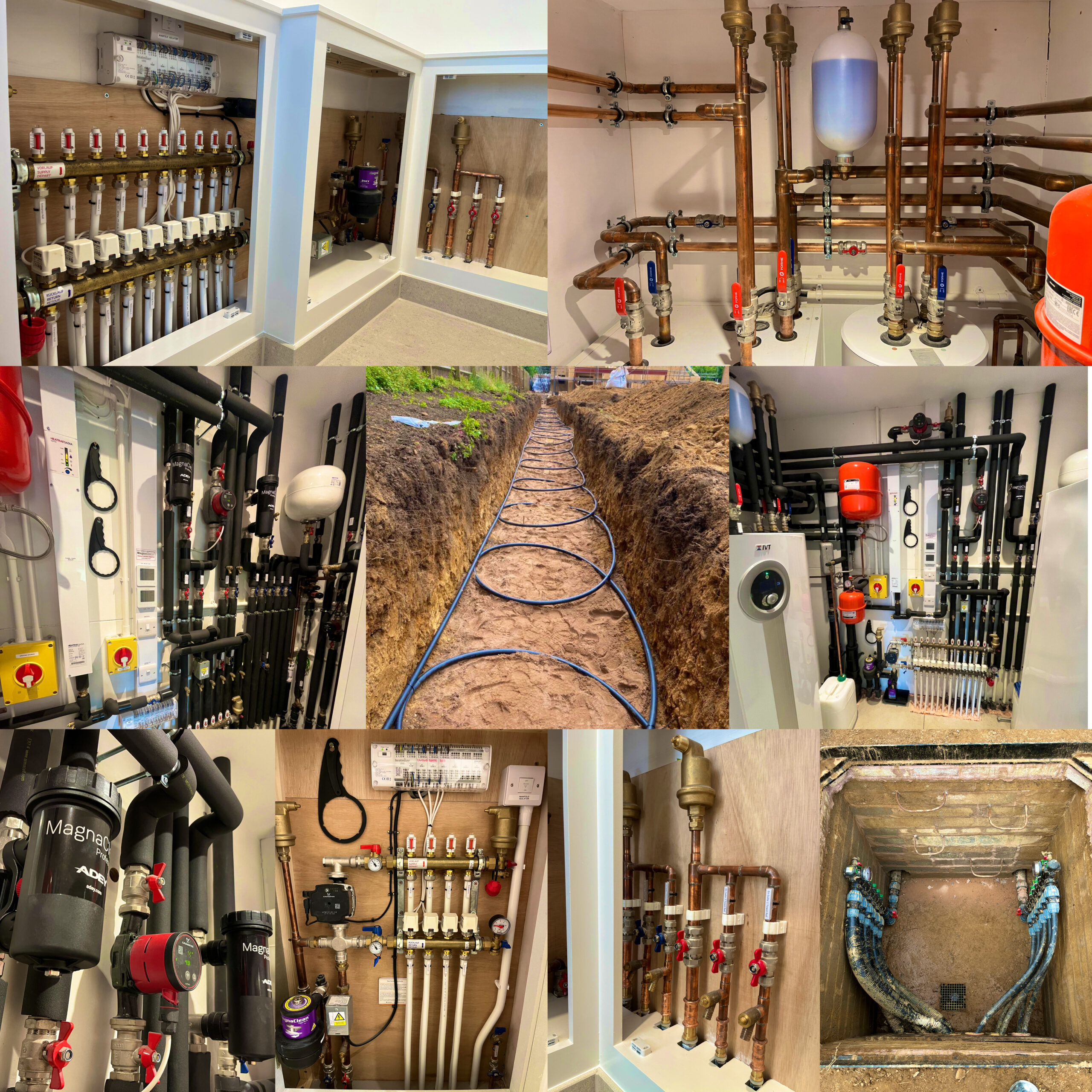
One project I am particularly proud of was installing a ground source heat pump system in 2023 for an elderly retired couple who were building their forever home. Their goal was to create an eco-friendly and efficient heating system that would also be easy to maintain as they aged. The property was knocked down and a detached timber framed house was built in its place (4 beds, 2 En-suites, 2 main bathrooms and 1 downstairs toilet).
The first challenge was designing and installing the ground loops, which required careful planning to ensure they were long enough and correctly spaced to provide the required heat output. I created an AutoCAD drawing to precisely map out the loop layout, ensuring compliance with system requirements.
This was used by the groundworks contractor to dig the trenches, into which I then laid the pipes, ensuring each loop connected back to a custom-built manifold. Every loop was pressure-tested before being covered, and I insulated and sleeved the return pipes to minimise heat loss and prevent damage.
Another significant challenge was the plant room’s limited space. I carefully planned the layout to fit the heat pump, buffer tank, and hot water cylinder in a way that remained accessible for future maintenance, with all pipework neatly labelled.
A particularly complex challenge arose when installing the underfloor heating upstairs. Since the builders had already laid a timber floor over the joists, I couldn’t install the pipework in the usual manner. Instead, I had to feed the heating loops from the ground level, threading them through aluminium trays and joists—a highly intricate process that required precision and patience but one that ensured the customer received a fully functional system without disrupting the building schedule.
To maximise efficiency, I also designed the hot and cold-water system without any joints in the floor, preventing potential leaks. The system was looped from least-used to most-used taps, reducing stagnation, and pipes were fully insulated for frost protection.
For the towel rail circuit, rather than placing joints in the ground, I routed all connections into a utility cupboard, where they could be accessed above ground with isolation valves and automatic air vents, simplifying maintenance.
A final concern from the customer was that the towel rails might not get as hot as they were used to, given that ground source heat pumps run at lower temperatures. To address this, I installed a small electric boiler dedicated to the towel rail circuit, ensuring they reached the desired warmth.
Once the scope of the project was defined, I set to designing and specifying the system. From the outset I decided that a project of this scale and standard required only the best components, no push-fit, no sub-standard parts and all pipework would be copper except when in the ground.
Heat Pump Equipment:
IVT Greenline HE E17 Three Phase Ground Source Heat Pump, IVT Buffer Cylinder Tank BC 100/3, IVT Slingtank FW 504/3 bar, IVT HE Internal Sensor. I chose this as it offered the best system components.
Ground Loop Equipment:
HDPE Black Pipe. I chose this as it is tough, solid, highly versatile with low friction and high flow rate.
Pipe Insulation:
Armaflex EVO Tuffcoat Class O 1m Underground Waterproof Pipe Insulation (19mm wall thickness). I chose this as it can be buried on underground pipe systems without fear of corrosion or damage.
Automativ Air Vent:
Spirotech SpiroTop AVV 1/2-inch Brass Automatic Air Vent. This was selected for removing free air from the system to prevent component damage and system failure. It removes all circulating air and microbubbles and reduces the need for manual venting and leak free.
Central Heating Circulation Pump:
Grundfos Alpha 3 25-80 circulator pump. I selected this due to the circuit size and its ability to auto-adapt to continuously adjust output performance to match actual heating demand. This helps the customer to reduce oil usage, emissions and increases energy efficiency of the system.
Secondary Hot Water Circulation Pump:
Grundfos Comport UPS 15-14BA GB (80) Brass Comfort Hot Water Circulator Pump with auto Adapt. I selected this to meet the demands of the hot water circuit size, low noise output & reliability
Filters:
Adey MagnaClean Professional 2 filter. This was selected for the primary circuit to ensure all debris is collected for years to come, maintaining longevity of system.
Adey MagnaClean TwinTech high performance filter. I installed this on each underfloor heating manifold to filter bacterial growth in the lower temperature areas of the system. Each filter allows access to insert biocides to flush, should this be required.
Underfloor Heating Controls
Heatmiser Floor Probes, Heatmiser Thimble Air Sensors, Heatmiser Programmable Room Thermostat, Heatmiser Actuators, Heatmiser Wiring Centre, Heatmiser Neo Hub. The Neo Hub connects to your home broadband router and wirelessly to the neoStats in the home. Programmable room thermostat can also work as a programmable thermostat or as a timer. Floor and air sensors measure the average temperature in a room.
Pipework:
Unbranded – N-Feed, Y-Shaped 2-Way Fitting. I decided to loop the hot water around the system and allow water to bypass even when in use. This was done to prevent any delay in hot water reaching the other outlets on the system. It also allowed easy isolation of individual outlets.
Pert-Al-Pert Underfloor Pipe: I selected this 5-layer composite pipe to combine the benefits of metal and plastic. The aluminium core prevents the ingress of oxygen and helps it to remain stable, safeguarding against any future leaks.
This project stands out because of the thoughtful design, problem-solving, and future-proofing I incorporated. From working around space constraints to ensuring ease of maintenance and adapting to construction challenges, I delivered a system that was not just efficient but tailored perfectly to the customer’s long-term needs.
What made this project unique was the level of planning and foresight for future maintenance. Since this was the couple’s forever home, I ensured that the system was designed to be as easy to maintain as possible as they aged.
One standout feature was that each ground loop was individually isolatable and labelled, allowing for quick identification in case of future maintenance. To further simplify servicing, I installed a cold-water point and isolator at each manifold, along with a waste pipe, so that if the system ever needs draining, it can be done cleanly and efficiently at the same location, without dragging hoses through the house and risking leaks or mess.
The upstairs underfloor heating installation also made this job particularly challenging and unique. Since the builders had already laid a timber floor over the joists, I couldn’t install the pipework in the usual way. Instead, I had to thread the heating pipes through aluminium trays from the ground level, feeding them carefully through the joists. This was an extremely intricate and labour-intensive process, but by adapting to the situation, I ensured that the customer received a high-quality heating system without delays to their build.
Additionally, I eliminated all joints in the floor for the hot and cold-water system and towel rail circuit. Instead of having underground connections, everything was routed into an accessible utility cupboard with isolation valves and automatic air vents, making future repairs or modifications far easier and safer.
To protect the longevity of the system, each manifold was also fitted with a low-temperature filter, helping maintain efficiency and reliability over the years.
This project stood out because it wasn’t just about installation—it was about smart problem-solving, anticipating future challenges, and ensuring long-term ease of maintenance. I am particularly proud of how I adapted to on-site challenges while delivering a system tailored perfectly to the customer’s needs.
The end result for the customer was a highly efficient, low-maintenance, and future-proof heating system that provides consistent warmth and comfort throughout their forever home.
Thanks to the ground source heat pump, they now benefit from significantly reduced energy bills compared to traditional heating methods, making their home not only eco-friendly but also cost-effective in the long run.
The underfloor heating ensures an even and comfortable temperature throughout the property, eliminating cold spots, and each room can be individually controlled for maximum efficiency. The system is designed to be low-maintenance, with no joints in the floor, individually isolatable ground loops, and clearly labelled pipework, making any future servicing straightforward and hassle-free.
One of the biggest advantages for the couple is peace of mind. The easy-access manifold system, complete with built-in water points and waste pipes, ensures that draining, refilling, or maintaining the system can be done quickly and cleanly—without any disruption to their home.
By carefully planning for their future needs and overcoming installation challenges, I provided a heating system that is efficient, reliable, and built to last, giving them comfort and confidence in their new home for years to come.
You have already voted for this category.

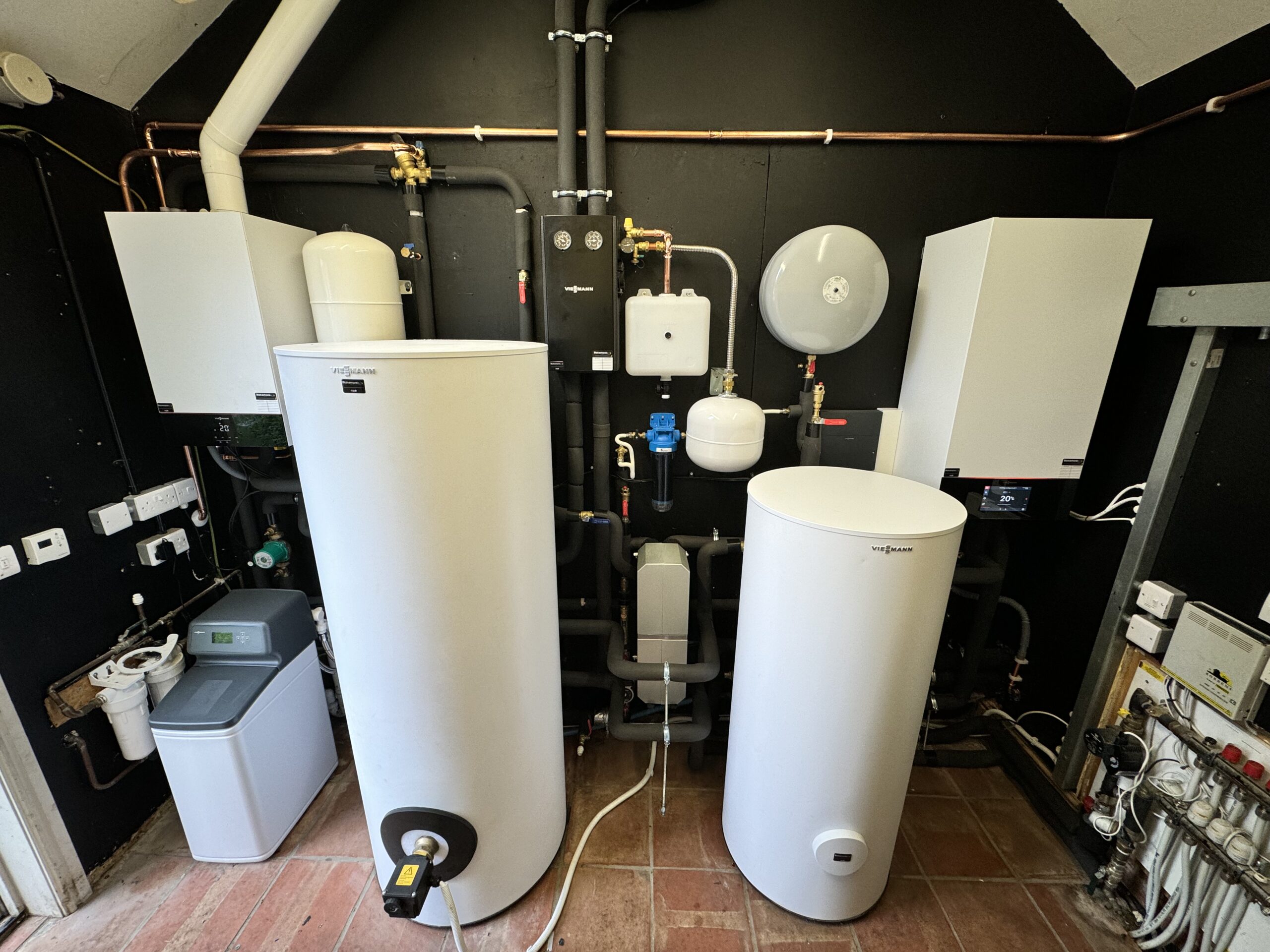
In the past 12 months the project that stands out was a hybrid solution I presented for a client who had ongoing issues with 2 high temp Daikin air source heat pumps.
The project came to me because the customer had contacted an alternative heat pump manufacturer, Viessman, who I have worked with for years. Their team had been to site to look at the situation and conduct heat loss reports and knew that they needed an expert on renewables to take a look at the job. So, they recommended myself to the customer, and shared the project details and heat loss calculations with me.
The property is a 4-bed stone cottage set in its own land with no natural gas and the heat load / loss was around 16kw. The customer had got in touch initially with a view to repair the units: numerous engineers had been out, including the original manufacturer, Daikin, but had failed to sort the issues. After a couple of visits myself, and still no help at all from Daikin as the units were now obsolete, we decided to put a plan in place to renew the units the following summer to avoid any risk of the customer being without heat in the winter.
In the meantime, I made a few repairs and adjustments to the system to ensure that the customer wouldn’t be left without heat or hot water in the colder months. For example, the customer had 2 x 300L cylinders installed, which meant the heat pumps were struggling to heat the water efficiently, so we decommissioned one of the cylinders as he didn’t need both of them running all of the time and this was putting strain on an already poorly installed system.
The main problem was that a standalone heat pump wouldn’t cover the full load of the house, so, we needed a solution to be able to bring in a secondary source as a back-up that would also operate efficiently as a standalone heat source, in case there was any issues with the heat pump. The customer had already been through two Christmases without heating and hot water and didn’t want this again.
So, we agreed that would find a solution that would compromise of a bivalent hybrid system that would also provide heat and hot water if the heat pump was to ever fail.
The customer also had a solar thermal system that he wanted to be decommissioned and removed as it had never worked. He didn’t want to spend any money renewing it however, I advised that with a new pumping station I should be able to get this going again without renewing anything up on the roof: it just needed a bit of TLC. The customer listened to the recommendation and agreed that we should take a look at it in order to save costs later down the line.
Internally the house had UFH that had never worked properly, it needed a higher temp than the normal 50/55º as it hadn’t been sized properly, so they were running very inefficiently and uneconomically. The solution needed to be a heat pump that could run at higher temperatures while at the same time still being quite efficient.
In my opinion, with a hybrid system, we should be getting 80% of the heating load from the heat pump to make it worthwhile, the challenge here was to find the right balance with the right equipment.
My go to supplier is Viessmann because I think they have the best products on the market and a solution for nearly every application, plus they have viguide and vicare app built in which allows the customers to control all Viessmann products via an app and also allows myself to have remote access to see what is going on or to tweak anything, if needed. On a project like this, bit me and my customer thought this would be essential.
In this particular instance the manufacturer, Viessmann, didn’t have the off the shelf solution I required and only had two hybrids running in the country with the vitocal 150-a air source heat pump at this point.
The problem I had was that the 150-a heat pump wouldn’t take solar thermal nor would it allow a cylinder to be plate loaded, so I had to come up with design and specification that would work.
We would use a 16kw Viessmann Vitocal 150-a ASHP, which would give us 12kw at dot and then a 19kw Viessmann 100-w log system boiler, to help with the bivalent systems elm but also be capable of providing the full testing load in case of a heat pump issue.
The Viessmann solar thermal pump station would then be taken back to the 100-w which would allow it to be visible on the viguide and vicare app and give us some control over it so that we could see the generation.
We would use the 300l Viessmann cylinder and use the large bottom coil for the solar thermal, we would then plate load the cylinder from the heat pump, which is where it got tricky. What we did was use a pipe stat and a flow switch, so, as soon as the flow switch senses that the heat pump has gone into hot water it would power the pipe stand, and, as soon as that sees a rise in temperature, it would power the brass pump for the cylinder recharge. To date, this has been working very well.
What I then did also was utilise the four pipes on the on the system boiler and used the top coil on the cylinder so that if the heat pump failed and there was no solar thermal, the gas boiler could charge the top half of the cylinder so they had hot water.
This meant that every aspect of the brief was covered.
The Viessmann vital 150-a ASHP has a 8kw back up heater should the gas run out and the heat pump fail, and, we even installed a 5kw immersion in the cylinder as another element of insurance in the instance that everything else should everything fail.
The benefit here for the customer was that he was covered in every eventuality, it was all under one warranty with the manufacturer in case there was a need for repairs, and that the systems talks seamlessly to each other so he and I could both see it from our retrospective apps.
The uniqueness about this job was that we needed to cover so many outcomes for the client, which we eventually achieved.
It also stood out due to the fact that this was the first of its kind in the UK for the manufacturer, Viessmann’s, products and, coupled with this, the fact that there was no existing design for what I wanted to do. So, I had to start from scratch and design a completely unique solution myself to achieve what needed to be achieved. And, of course, it had to work.
In total, the project was completed over a two week period.
The first stage was to decommission it all but leave the original hot water up and running, so that the customer wouldn’t suffer over the winter. We fitted the heat pump externally and then, in one day, swapped the cylinder across and got it back on the immersion so that they had water temporarily to the house. We had to work around the cylinder, which was challenging, but eventually we removed it and were able to fit it into position.
It also stood out because I had to use various skills to get it completed, not just from an installation point of view. The design aspect of this job was crucial and took everything that I have learnt and know to be able to have pulled this off, and not just to pull it off, but to get it to work effectively.
From an installation point of view, even though I had a bit of room, it was still a challenge to fit everything into the space I had, especially as I wanted to position everything in an accessible set-up to ensure that it could be easily serviced and maintained.
Finally, aesthetics was important here too. I wanted the job to look the part so I transformed the plant room into a nice area for the customer that he could also use as storage. This meant that, once the installation was complete, we plyed and painted the plant room to leave them with a pleasant space, as well as an efficient system that they could absolutely rely on.
Ultimately, he got what he needed: reliable heating on a bivalent system that will provide back up should the heat pump ever fail.
They will have hot water provided by solar thermal during the warmer months, with the heat pump picking up the rest of the load but, if there is any failure from other sources, the gas boiler will provide hot water. So, they have ultimate peace of mind.
The electrical back up also acts as a last resort to provide some heating and hot water.
Further to this, they also benefit from remote access for the customer and myself, so, any system alterations can be made and any issues that arise can be seen remotely.
This will allow me to inform the customer that they need to do something, or that I am able to place the warranty call in a responsive manner without a site visit.
Currently, the heat pump is running at a scop of 3.5, which is still above parity with gas running costs, bearing in mind this is a high temperature system and is running 55c flow – so we are pleased. The current running costs are less than the old system.
I’d be lying if I said the job hasn’t been without a few hiccups. It’s something that hadn’t been done before so we were stepping into the unknown. Only 3 hybrids of this kind existed prior to this project, and none with solar thermal. In fact, due to it being a genuine first-of-its-kind, of the back of this, the manufacturer, Viessmann, is bringing new updates to its software that engineers can go out and add via their computers. With this it brings changes to settings and additions of news ones which are there to improve how it runs and the operation of the system. More updates will come over time.
Ultimately, we created a system that works well now and is future proof – if the customer ever wanted to get away from the gas back up, we could add another heat pump as a cascade. If they ever added PV and battery storage then we will be able to incorporate this.
So, the installation is far from just a short-term solution, it was an investment in something that works well now and will only improve as time goes on.
Plus, it is covered for every eventuality which is what the customer needed.
You have already voted for this category.

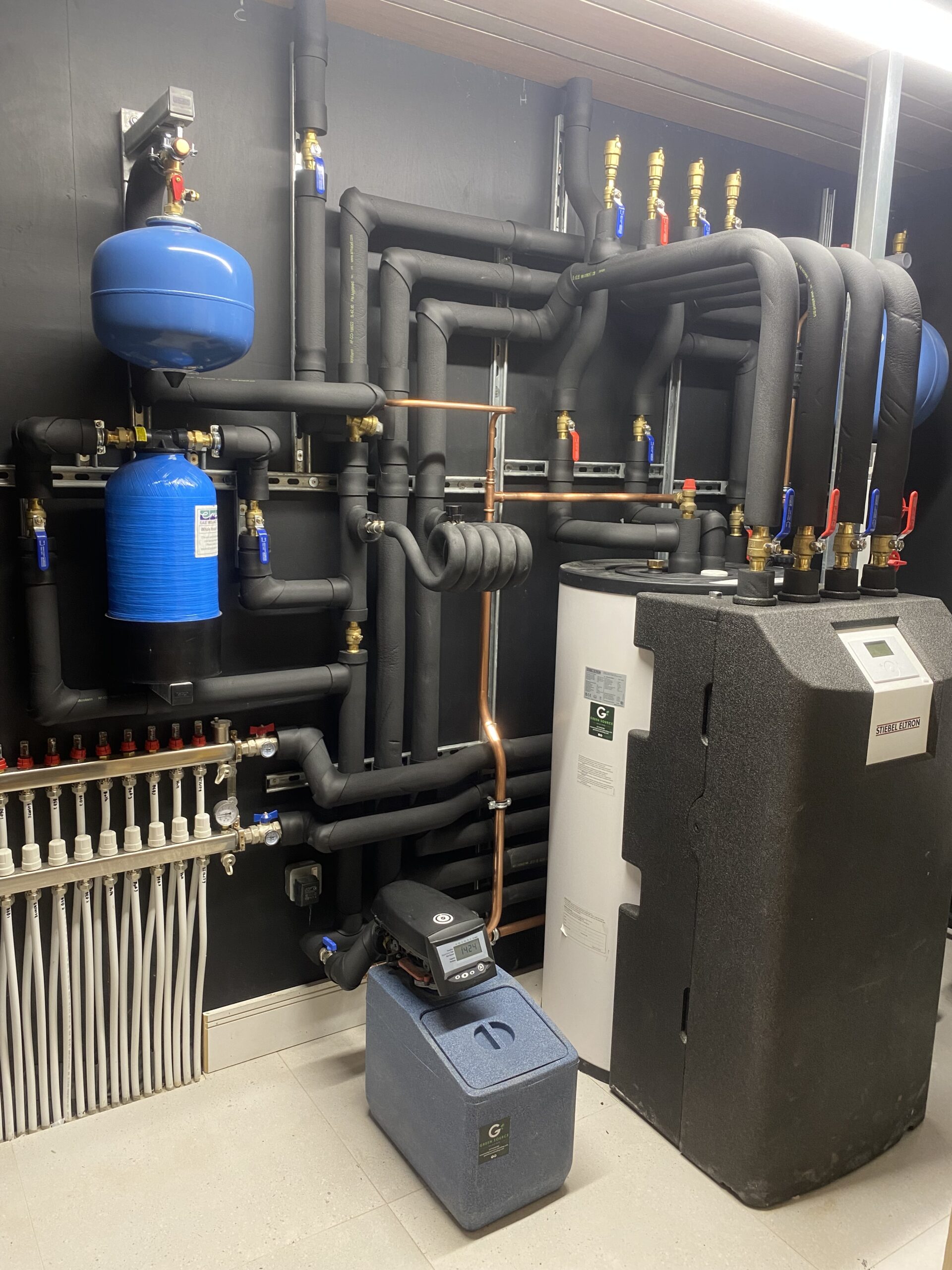
I was proud of this project because it gave me the opportunity to be on the cutting edge of renewable technology. I learned a lot about low temperature heating design in a house with an extremely low heat loss per m2.
The property was a large new build the property is 3099sqft, it has 4 bedrooms and 4 bathrooms, Passivhaus, as it is a requirement, with MVHR, Air source Heat Pump and rainwater harvesting installed by me, and solar panels and batteries to follow.
The MVHR was also a requirement, but would have been installed regardless. The customer was unsure which direction to go in terms of heating and cooling the property, so I recommended the combination of a Stiebel Eltron WPL A-07 premium heat pump and Zendher climate switch MVHR. The MVHR unit is in the plant room, and has a 96% heat recovery, but will also supplement with passive cooling in the summer.
This was the first project on a full open loop design with no third-party components and ran completely off of one pump. It was between an air source and a ground source but an air source was selected in the end due to the very marginal gains this type of property would get compared to the installation cost of boreholes for a ground source.
From start, the customer allowed me to make all my own choices and do whatever I pleased. I had complete creative freedom with it as they just let me get on with the project, and they very happy with the end result. I designed the system in such a way that the heat demand would be low, and flow temperature low. But the open system volume high for peak efficiency. I designed the system in such a way that the heat demand would be low, and flow temperature low. But the open system volume high for peak efficiency.
The property had a 2.6kw heat loss. Because of this it was imperative a heat pump which could modulate down as low as possible was selected. The system was designed to be completely open loop, and the entire system is run off the single PWM controlled pump inside the buffer less HSBB 180 cylinder. The HSBB 180 [cylinder] was selected due to its PWM pumping capabilities which could cover the whole house off a single pump and maintain constant delta T. The system was designed to 35-degree flow, however in usage the heat curve was able to be dropped lower than design and the temperature remained comfortable.
The system is performing well since commissioning approx. 8 months ago, averaging a combined COP of 5.96 at an average outdoor temperature of 11.7 (stiebel onboard monitoring). The project was a vanity project for me as a way to showcase my skills. By the time the solar panels are in, bills should be zero or negative and they can run almost entirely off the grid and sustainably.
Already they are almost there as the water is on a separate tank and uses rain water harvesting. I worked closely with the manufacturer from the beginning as they were able to give me recommendations on the specs needed for this project. The MVHR system was designed by Green Building Store and was installed by myself.
The rainwater harvesting tank was in the back garden and was made up of a 3000 and 4000 litre harlequin tanks. The pump only feeds one outdoor tap for gardening and cleaning purposes. They also were wanting to use my project as a case study for their website, so they were closely attached to it with me. The heat pump and cylinder were all sourced from Steibel Eltron, the pipes all were purchased from local merchants and the water treatment system was from the East Midlands Water. The underfloor heating was sold by UFH1, and was designed to 35 degrees on a room-by-room basis, but I found I could actually run the heat curve closer to 0.2-0.3 and maintain comfortable temperatures.
The reason this project stood out to me is that the build/installation was fundamentally focused on sustainability. All building materials were locally sourced, a percentage of the insulation used was made up of local hay bales and lamb’s wool, the heat loss and air tightness were kept to an absolute minimum to meet Passivhaus standards and ensure the MVHR could perform at its best.
It further allowed me to demonstrate my best pipe fitting skills with a 28mm bender to keep flow rates high, and also get really stuck in with the design side of things and incorporating as many interesting products as possible. I also fitted a rainwater harvesting system, and a small water quality improvement setup with a water softener and a silver impregnated carbon whole house filter. The water softener and carbon filter were from East Midlands water. This project was different from all my others as it was my first time working on a full passive house. I have had more since, but at the time, this was different for me. The project was a self-build so all in all, I was on and off the project for over a year, but the install on site took two and a half weeks. This includes the plant room and heat pump, all underfloor heating and two mezzanine radiators. I was also there for the MVHR.
The customer was thrilled with the quality of all aspects of the installation and the comfort of the home as a result. The carbon usage is drastically reduced due to the reduced heat loss and renewable technology heating the property. No gas is used in the property, and water wastage is greatly reduced thanks to the rainwater harvesting system. I haven’t been back to the site since completion, but I have been able to keep on top of the heat pumps progress online and the SCOP score hasn’t dropped below 5.9 and the heat use tariff hasn’t dropped since the install. The house doesn’t need to be heat loaded if electricity is expensive you don’t have to heat the house and vice versa is electricity is cheap. I have been recommended to other developers thanks to the client, as they were a developer.
You have already voted for this category.

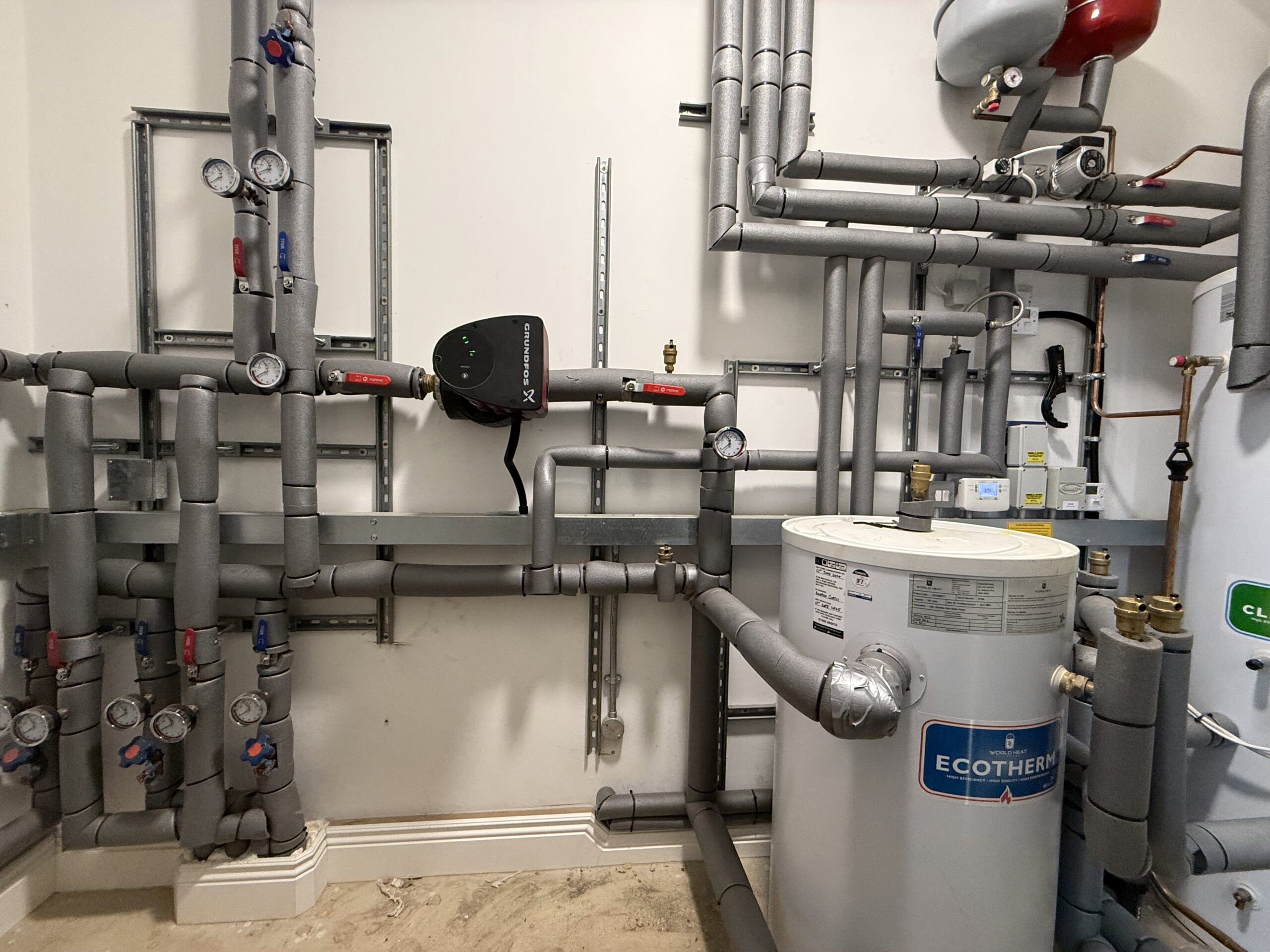
I’m really pleased with the outcome of this project from design and planning through to the installation. The property is an old 1900s farm house in an exposed location and I was tasked with designing an efficient low temperature heating system (along with the rest of the plumbing works).
This is a large home is spread over 3 floors, with 4 bedrooms, 2 ensuites and 2 bathrooms, plus boot room, kitchen, snug, living room and office. I approached the planning by first evaluating the property and the heating options, focusing on sustainability, moving away from the existing oil boiler – as the customer wanted to future proof the property.
I did an evaluation on the property and pitched two ideas to the customer – a ground source vs air source heat pump system. Initially, the ground source pump was a fantastic option as this is a large property with land, so the customer had the space to complete the project. However, when I started to crunch the numbers, the figures put the customer off, so I instead went with the air heat pump option.
After completing the heat loss calculations (as shown later in the entry) I recommended two heat pumps to reduce heat loss. The customer could have had a ground source heat pump, LPG or oil boiler, but I advised on ASHPs due to the cost. I did this firstly due to the size of the property, and secondly due to the colder weather we have been having. I could’ve fitted a 17 but this would’ve been on the cusp and potentially struggled in colder weather (as shown by the heat loss calculations) so I chose two 210 heat pumps (as the heat loss calculations showed the heat loss to be 16.6 – again shown below).
One of the pumps would be on all the time and the other would only come on in colder conditions (3 degrees and below). Because the system was being designed for low temperature, the customer was happy to go ahead. This also determined the UFH manifolds and what spacing was needed for each room; I went for a mixture of 150 mil and 100 mil centres depending on the calculations.
As it was a full refurb, we were able to install underfloor heating throughout which spans 3 floors. A couple of areas went in a screed and the rest was installed on an overlay system – in total we had 4 manifolds in the property which would boost the overall heating performance of the property. As well as the UFH system, and the heat pumps, I recommended added insulation across the property. For example, one the first floor, under the timber flooring, there was no insulation so I knew the customer would need to add this to prevent heat escaping. In the walls, there was 25ml of insulation, but I recommended upping this to 65ml which was completed as part of the property refurbishment.
We just had the one pump serving the underfloor heating in the plant room. I removed the mixers as well so we could run it strictly off weather compensation. We had 2 x 10kw grant Aerona heat pumps working as a master and slave. These fed into the buffer then we had a 42mm header and a Grundfos magna 1 32/120f pump serving the underfloor heating with 28mm to each manifold.
We had a variety of pipe spacing throughout the property to perfectly match the heat loss.
The customer insisted on thermostats but these are set at 23 degrees and just acting as limiters. The living areas hover around 21 degrees and the bedrooms around 19 degrees. The system has worked extremely well and the customer is more than happy with the outcome.
I went for 2 x 10kw Grant Aerona heat pumps.
I went for Grant as I’ve installed a lot and I’m very familiar with the units and controller.
These were purchased from our local plumbing merchant Wolseley Plumb & Parts in Wolverton.
Grant was chosen over an LG as Grant is much more user friendly (when installing an LG previously, I found these to be confusing).
I then went for a World Heat hot water cylinder and a World Heat custom made buffer. These are made in Manchester. We then had a Grundfoss Magna1 32/120f pump serving the whole heating system. It’s a great pump and runs silently. I used Wunda for the underfloor heating as I’ve used them for years.
This project was different and unique to all the others I’ve done as the property was an old 1900s farm house, in a rural exposed location outside of Milton Keynes. It just goes to prove that heat pumps aren’t just for new builds. It was quite testing from start to finish to make sure everything was absolutely spot on.
The project was testing due to a number of factors, the first being the different elements to the project – from consultation (ground source vs heat source), recommending additional measures for effectiveness (adding or upgrading insulation), decommissioning and installing the new heating system, fitting the plant room and the hot and cold-water system.
Because of the size of the house, and as it was being completely gutted and renovated, I really felt as though I was project managing the works going on in the house.
The UFH system presented problems due to the property age and size, so we had to use an overlay system, sticking the boards and running the piping across the top, on all 3 floors – which naturally took up the bulk of the project. The hot and cold-water system was a multi-layer LCP pipe and we used a small door for hot water return which would be run in small radials. There was also a lot of back and forth making sure the system was working as it should be across all 3 of the floors.
I had to ensure the insulation levels were up to scratch and worked with the builder on this, as I wanted to prevent as much heat loss as possible – so was constantly going round the property checking the levels of insulation.
Again, as it was an older property, I had to make sure the piping was up to scratch and change this where appropriate and the better all of this was working, the better the system would work as a result. This all needed to be done to get the heat pump working as effectively as possible. It really made me think which I really enjoyed.
The pipework in the plant room is where I could showcase my skills, I had many compliments which was nice.
We started the project in January and completed it in July as it is a large property and the different elements to the project – the bathrooms, the hot/cold water system, UFH and heat pumps.
The customers were more than happy with the final outcome. They were keen to get rid of the old oil boiler and go for something green which we completed here. The heat pumps were a perfect fit for their budget. The house is nice and warm 24/7 and they’ve not had to adjust or touch anything.
They were eligible for the BUS grant, so they had £7,500 paid directly into their bank account.
So far, they’re spending less than they were on heating oil and there’s no reason why that should change.
My plan for this installation was to use the new grant smart controller which would’ve allowed remote monitoring but the launch date was pushed back till after the completion of the project. When it was finally released, it turned out it wasn’t compatible with a cascade system so while I cannot provide the SCOP, I can make an educated guess as I keep an eye on energy usage. My estimations make the SCOP of around 4 (or just under). I was able to reach this conclusion because the heat loss report shows an estimated heating SCOP of 4.25 and hot water at 3.46 and a total yearly running cost of £3,117. Currently, we’re on track for a yearly running cost of £3,200-£3,500 calculated at £0.32 a kWH (the same as the heat loss report). This is estimated but imagine it to be quite close which is a great result.
It’s running a lot better than the previous oil boiler and even in the harsh, cold winter (-5 degrees!) which is a lot lower than the heat pumps are designed for, and the customer has had no issues.
Appendix M – Heat Pump Summary
SPACE HEATING
WHERE OTHER HEAT SOURCES ARE USED
WATER HEATING
PROPORTIONS, ENERGY CONSUMPTION, AND PERFORMANCE
RUNNING COST
Appendix K – Emitters and Performance
Appendix L – Fuel Comparison
Appendix H – Review of Heat Loss (Part 1)
Appendix A – Summary of Results
Worst Performing Room:
Energy Calculation Method:
You have already voted for this category.
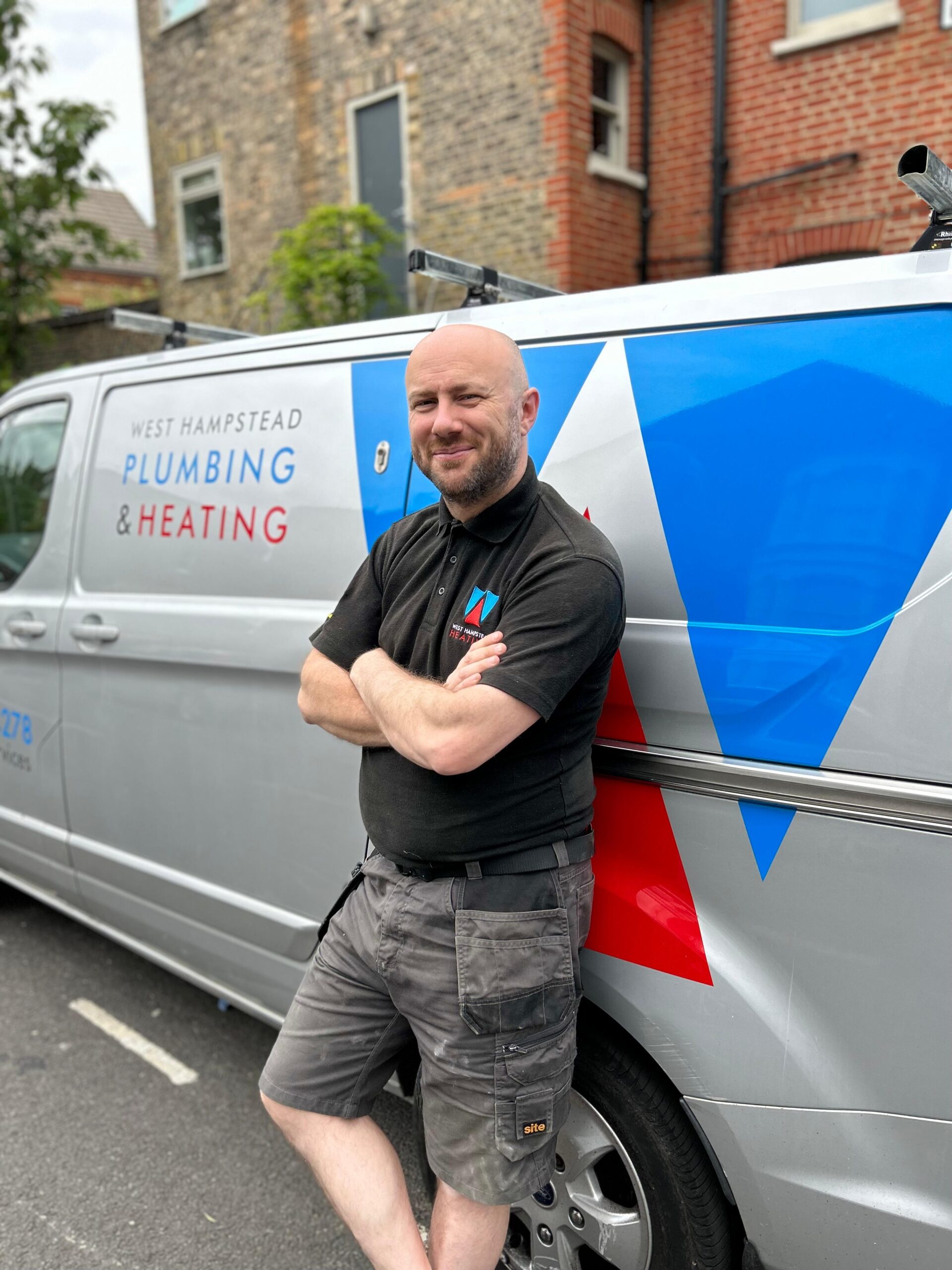

This project involved the installation of a highly sustainable, renewable heating system in a 1900s Victorian terraced house in London, which was undergoing refurbishment. After refurbishment and extension, it is a five-bedroom property with one bathroom and one shower room. The client’s primary goal was to disconnect from the gas grid while ensuring an energy-efficient and comfortable home. Sustainability was at the heart of this project, and our approach focused on minimizing environmental impact while maximizing efficiency and longevity.
The customer’s primary concerns were eliminating reliance on gas, they wanted a fully renewable heating solution while maintaining efficiency and comfort; heat loss reduction as the home had restricted insulation upgrade options due to planning and space limitations.
To address these challenges, we designed a compact system with two NIBE cylinders linked in series, eliminating the need for additional buffer tanks and reducing space requirements; used internal wall insulation and draught-proofing to enhance energy efficiency while respecting the home’s character; developed a low-temperature heating system integrating underfloor heating and radiators, ensuring optimal performance with minimal energy waste.
Sustainable Challenges & Solutions
The client wished to install the heat pump under permitted development while ensuring minimal visual and environmental impact. The chosen solution was to mount the heat pump on the second-storey flat roof, an area that would not compromise garden space or aesthetics. By lifting the unit using a crane rather than heavy construction, we minimized ground disturbance and material waste.
The Nibe heat pump was integrated into an open-loop system designed to operate at the lowest possible flow temperatures, reducing energy consumption. Weather compensation controls were installed to automatically adjust heating output based on external temperatures, ensuring optimal efficiency and reduced energy waste. After insulation upgrades to certain areas, we got it down to 6.5KW and a design outside temp of -2ºC
The house’s construction posed challenges for insulation, but we overcame this by working with the client to install internal wall insulation using environmentally friendly materials. This improved heat retention without compromising the home’s Victorian character. Additionally, triple-glazed windows and draught-proofing measures were recommended to enhance efficiency further.
Given the constraints on internal space, we optimized the heating system to eliminate the need for a buffer tank, thereby reducing material use. The system was designed to operate efficiently with only two NIBE cylinders linked in series, ensuring adequate (300 litres) hot water supply while using fewer resources.
Heat Pump: NIBE F2050-10 (high-efficiency air-source heat pump with low global warming potential refrigerant)
Cylinders: Two NIBE cylinders linked in series for reduced heat loss and energy efficiency
Controller: NIBE SMO S40, providing advanced energy management for maximum sustainability
We chose NIBE products because of their strong environmental credentials, including high seasonal coefficient of performance (SCOP) ratings, which ensure lower carbon emissions and greater efficiency. Additionally, the system’s open-loop design allows for maximum energy conservation without requiring additional components that would add to the environmental footprint. I designed the system, and I would say it took a good couple of days in total to reach the final design over multiple iterations. We explored MVHR as an option initially but there wasn’t the practical space to use this, and the structure of the house made it unviable.
This project, while not the largest or most technically complex, stood out due to the unique challenges we had to overcome. The Victorian terraced house had limited internal space and strict planning constraints, requiring innovative thinking to ensure a successful and sustainable installation.
One of the biggest challenges was heat loss management. The existing building fabric limited insulation upgrades, so we worked closely with the client to identify the most effective areas for internal wall insulation without compromising living space. We also had to design the underfloor heating to complement the radiators, ensuring both systems could operate at the same low flow temperature (45ºC) to maximise efficiency. To optimize performance, we carefully calculated pressure losses, enabling the entire system to be powered by a single high efficiency heating pump, reducing energy consumption and system complexity.
We chose NIBE products due to our knowledge of their product and also their pedigree in the heat pump world. They also provide excellent product & technical support. They have been integral to our gaining our MCS accreditation and success in installing heat pumps. Knowledge of any heat pump ecosystem is key, and we are able to do this with Nibe products due to having used them on a number of installations. Radiators were by Ultraheat, and we chose these due to the flexible sizes on offer and also accurate outputs at different flow temperatures.
The installation location also added to the project’s uniqueness. The heat pump needed to be sited discreetly while adhering to permitted development rules, so we opted for a second-storey flat roof installation. This required careful logistical planning, including a crane lift to position the unit safely without excessive disruption.
Despite these challenges, we successfully installed the system over a period of 24 working days, spread over several months due to coordination with builders.
Throughout the project, we showcased our expertise in designing and implementing sustainable heating solutions within tight spatial and regulatory constraints.
Our ability to adapt and provide a hands-on, premium service ensured that the final installation was both highly efficient and minimally invasive.
The customer is extremely satisfied with their new heating system, which not only provides a consistently warm and comfortable home but also aligns with their goal of living more sustainably. The transition away from the gas grid was a key priority for them, and they are proud to now rely solely on renewable energy for heating and hot water. By eliminating fossil fuel reliance, their home has significantly reduced its carbon footprint, contributing to a cleaner environment.
Financially, the customer stands to benefit from substantial energy savings over the long term. The NIBE heat pump operates at a high seasonal coefficient of performance (SCOP), ensuring that for every unit of electricity used, multiple units of heat are generated. This efficiency, combined with the smart weather compensation controls, reduces overall energy consumption, making it cheaper to run than a traditional gas system. Additionally, the system is designed for longevity, minimizing the need for costly repairs or replacements in the future.
Beyond financial savings, the installation process itself was a major advantage to the customer. With limited internal space and complex planning restrictions, they relied on our expertise to find a practical solution. We guided them through crucial decisions, balancing sustainability with practicality. Our flexible approach ensured that every challenge—whether related to space, insulation, or efficiency—was met with a well-executed, eco-conscious solution. The final result was a highly efficient, space-conscious, and future-proof heating system that met all of the customer’s goals while significantly lowering their carbon footprint. Currently the SCOP is at 3.3 which is set to exceed projections as this hasn’t completed a full heating season yet.
The end result is a modern, efficient, and future-proof heating system that meets the highest sustainability standards. The client not only enjoys lower running costs but also the peace of mind that their home is heated in an environmentally responsible way. As a NIBE Pro Installer, we will continue to support them, ensuring the system remains optimally efficient for years to come.
You have already voted for this category.

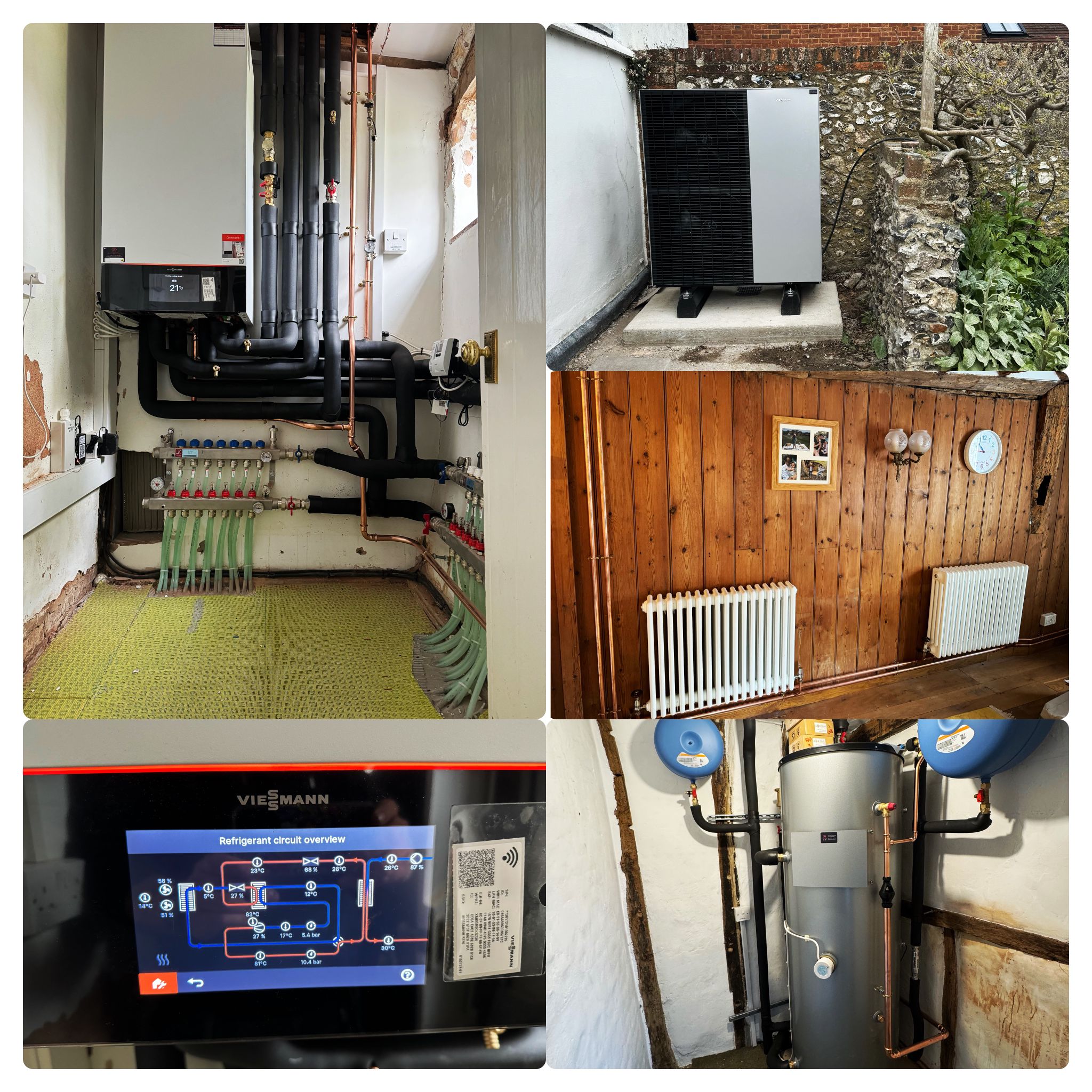
The owner of this property was the former Head of Sustainability for HMRC, someone highly knowledgeable about energy efficiency and committed to finding the best possible heating solution for their home. However, despite his expertise, he struggled to find an installer capable of delivering a system that met both his sustainability goals and the strict requirements of a Grade II listed building.
After extensive research, he discovered my company through Open Energy Monitor, and we began developing a plan to upgrade his heating system while preserving the historic integrity of the property.
This project involved a Grade II listed house built in 1700, covering approximately 200m². Multiple installers had previously stated that the work couldn’t be done, but we took on the challenge. The property’s loft was completely uninsulated, so we explored all possible options and carried out insulation improvements to reduce heat loss. These improvements made it possible to install a heat pump, ensuring the building could be heated efficiently while preserving its historic integrity.
We installed a Viessmann Vitocal 150-A 16kW air source heat pump in a 400-year-old, Grade II listed timber-framed solid brick property with very limited insulation.
We conducted a full heat loss survey and determined that, with some secondary glazing and insulation upgrades, the property’s heat loss would be reduced to 13kW at -3°C. Using this data, I set to work designing a brand-new system.
Since the property was listed on the National Heritage List for England (NHLE), heritage authorities were fully involved in the project due to its age and protected status. We also undertook a full heating system re-pipe in this three-storey, six-bedroom home, installing new copper pipework throughout. To ensure the heat pump operated at peak efficiency, we carefully designed the system with correct pipe sizing and optimised flow rates. Achieving the right flow is critical for system performance, maximising heat transfer and ensuring the heat pump runs efficiently across the entire home. By taking this approach, we delivered a future-proofed heating solution that meets efficiency standards while maintaining reliability and comfort for the homeowner.
As a listed building, we required permission for every aspect of the installation. We applied to install underfloor heating on the ground floor and designed it for a low-pressure loss under 20kPa, with a maximum flow temperature of 40°C.
Initially, we designed the first and second floors with standard panel radiators, but this was rejected due to the building’s listed status. As a result, we fully redesigned these floors using column radiators, ensuring a low-pressure loss of 25–32kPa, with pre-insulated 16mm MLCP and copper throughout.
Additionally, we incorporated a custom-built 250L Newark cylinder, which I helped design. Featuring 75mm insulation and a large 6m² coil running in reverse return, this setup delivered exceptional efficiency when recharging the hot water supply.
The entire system runs in a fully open-loop configuration with pure weather compensation, and it is actively monitored via Open Energy Monitor. Currently, it is operating at 500% efficiency.
For this property, there was only one choice for me: the Viessmann Vitocal 150-A air source heat pump. I selected this unit due to its superior controls and one of the best in the market weather compensation technology.
As a Viessmann Pro Partner, I work with the best controls in the industry, ensuring precise temperature regulation and maximum energy efficiency. The unit features an integrated buffer tank, which correctly manages defrost cycles, improving reliability and efficiency. It also includes a backup heater, providing additional support in emergencies and assisting with defrosting in extreme weather conditions. Customers benefit from a 7-year warranty, offering long-term peace of mind. Viessmann provides outstanding service and technical support, which many other manufacturers lack. I also monitor system performance, and the Vitocal 150-A consistently ranks among the best-performing heat pumps on the market due to its high efficiency.
Also, the indoor unit houses a 4-way valve that effectively handles defrosting, along with an internal backup heater to support the building if temperatures drop below -5°C or in the event of an issue. We complemented this system with a custom-built Newark cylinder featuring 75mm insulation and a 6m² coil to maintain high efficiency.
The benefits of these products for the customer include high efficiency and improved comfort levels. The steady-state heating system in a Grade II listed house also helps with the building’s construction by drying it out and preventing damp and mould, significantly improving the customer’s living conditions.
As the property was grade two listed, this system took a lot of planning to get correct accuracy, along with a constriction on usable materials and products – as well as how we installed them (no holes in property etc).
I was also told by the manufacturer that what I was planning to do with the open loop system via the Viessmann wasn’t possible. After doing calculations on the unit itself, I was very confident that the system I had designed was going to work and I was going to prove the manufacturer wrong – so putting everything on the line, I proved I could design a 16kw Viessmann open loop running off of one single pump in the unit.
What we had was lots of system volume a system designed to have an index circuit under 20kpa and full open energy monitoring system to show exactly how its runs. Currently running a flow rate of 35lpm with a pump speed of 85% and running at 500% efficiency, and the house maintains 20c through and hot water is set to 55c.
We designed a system with significant volume, maintaining an index circuit under 20kPa and integrating a full open-energy monitoring system to track performance in real time. The system currently operates at a flow rate of 35LPM with a pump speed of 85%, achieving 500% efficiency. The house consistently maintains an indoor temperature of 20°C, while the hot water system is set to 55°C.
The customer is very happy with the results and the system. After being told multiple times that a heat pump wouldn’t work in his home, he now has one of the highest-performing heat pumps to date. He also enjoys significantly reduced energy bills, which he further supplement with solar and battery storage. As a result, the owner is now highly active in promoting my company Customer Renewables.
We were fortunate to have a case study done for this project, and we have been highly commended at the National ACR and Heat Pump Awards 2025.
All performance results are available on heatpumpmonitor.org via Custom Renewables and Aylesbury, where the system is operating at 500% efficiency. The unit has been running on OEM, with a current SCOP of 4.2 in this Grade II listed property.
You have already voted for this category.